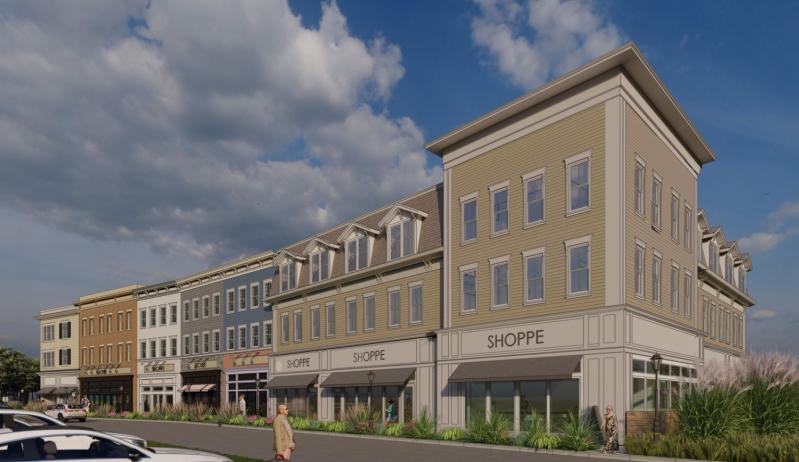Spurred by opposition to a large-scale development proposed for downtown Sag Harbor, Save Sag Harbor and a group of residents filed suit against the village on Friday in an effort to annul parts of its affordable housing legislation passed by the village board in June.
They are challenging legislation that allows mixed-use developments in the office and village business districts. If their Article 78 succeeds, it could prevent Adam Potter's proposed Residences at Sag Harbor, a 79-unit affordable housing and 30,000-plus-square-foot retail project, from being built. They are not challenging the parts of the legislation allowing accessory apartments in residential districts.
At the June board meeting when the law was adopted, it was met with applause. It eased restrictions allowing homeowners to build accessory apartments in the residential districts but also enabled development of mixed uses in the office and village business districts. Taking advantage of the new legislation, Mr. Potter, working with Conifer Realty, filed his proposal with the village the same day.
"This development would be larger than anything built in Sag Harbor since the watchcase factory in the 19th century," said Hilary Loomis, co-director of Save Sag Harbor. The affordable housing legislation "opened the door for it," she said. Joining the group in the suit are the Sag Harbor residents Kathryn Levy, Douglas Newby, Maziar Behrooz, Alastair Hawker, Aja Dekleva Cohen, Peter Acocella, and Laura Grenning.
"I can't comment on legal papers I have not seen," Mayor Larocca said in a phone call Saturday morning. "Rolling it out to the press without even alerting the village is very disappointing to me because we have been in conversation with Save Sag Harbor for the last few months. The concerns they were raising were principally associated with the Conifer application. To attack the underlying legislation without warning is calculated to put us in an awkward position."
Save Sag Harbor said it had provided a letter to the mayor prior to issuing a press release.
Under New York State law, the State Environmental Quality Review Act (SEQR or SEQRA for short) "requires the sponsoring or approving governmental body to identify and mitigate the significant environmental impacts of the activity it is proposing or permitting." If a board finds there would be no significant environmental impacts, it can issue what is called a negative declaration, which means a detailed environmental review is not required.
In Friday's letter to the mayor and the village board, Save Sag Harbor wrote, "The board's negative declaration under SEQRA, finding that [the affordable housing law] 'will not result in any significant adverse impacts on the environment,' was issued in the absence of such studies."
However, while the law was passed with a negative declaration, each project submitted under the law is analyzed individually, meaning Mr. Potter's application would still endure the SEQRA process.
He is free to press on with the project while the law is challenged. The village board could make a determination on Mr. Potter's application, which would allow the environmental review to continue. The SEQRA process could also set limits on the size of the project and address architectural criticisms.
The risk Mr. Potter runs now is largely financial. Should the court side with Save Sag Harbor and annul the housing legislation, then current rules in the office district, where Mr. Potter's would build his complex, would not allow for such a project.
Save Sag Harbor argues that the law, intended to promote affordable housing, did not properly consider the potentially destabilizing effects of its code changes on both the environment and the quality of life in the historic village.
The legislation was originally introduced in January, and months later, passed. Save Sag Harbor often had representatives at village board meetings questioning the impacts of the legislation. At the same meetings, members of East End YIMBY were also often present, pushing the board to make changes that would allow more affordable housing in the village.
"We strongly believe the village needs affordable housing for our work force and families. But this law encourages large-scale development in one of the most environmentally sensitive areas of our village, and one already plagued by parking and traffic problems. None of those issues were studied when the law was being drafted," said Ms. Loomis.
"The area is a FEMA flood zone, there's toxic waste onsite, and it would create major parking and traffic issues. Furthermore, it's dramatically out of scale with the historic core of the village, and to make room for it they plan to tear down four buildings that contribute to our National Historic District," she said.
Many of these issues would be dealt with as the application goes through the SEQRA process. "One way or another, that process will happen," said Sean McLean of MPACT Collective, who has been hired as a liaison to work with the village board, applicant, and residents.
"The village hired me to make sure that SEQRA was done correctly. Save Sag Harbor wants that process done correctly. It doesn't feel to me that they're that far apart."




